|
This section contains 737 words (approx. 3 pages at 300 words per page) |

|
When a vertebrate encounters substances that are capable of causing it harm, a protective system known as the immune system comes into play. This system is a network of many different organs that work together to recognize foreign substances and destroy them. The immune system can respond to the presence of a disease-causing agent (pathogen) in two ways. Immune cells called the B cells can produce soluble proteins (antibodies) that can accurately target and kill the pathogen. This branch of immunity is called "humoral immunity." In cell-mediated immunity, immune cells known as the T cells produce special chemicals that can specifically isolate the pathogen and destroy it.
The T cells and the B cells together are called the lymphocytes. The precursors of both types of cells are produced in the bone marrow. While the B cells mature in the bone marrow, the precursors to the T...
|
This section contains 737 words (approx. 3 pages at 300 words per page) |

|


